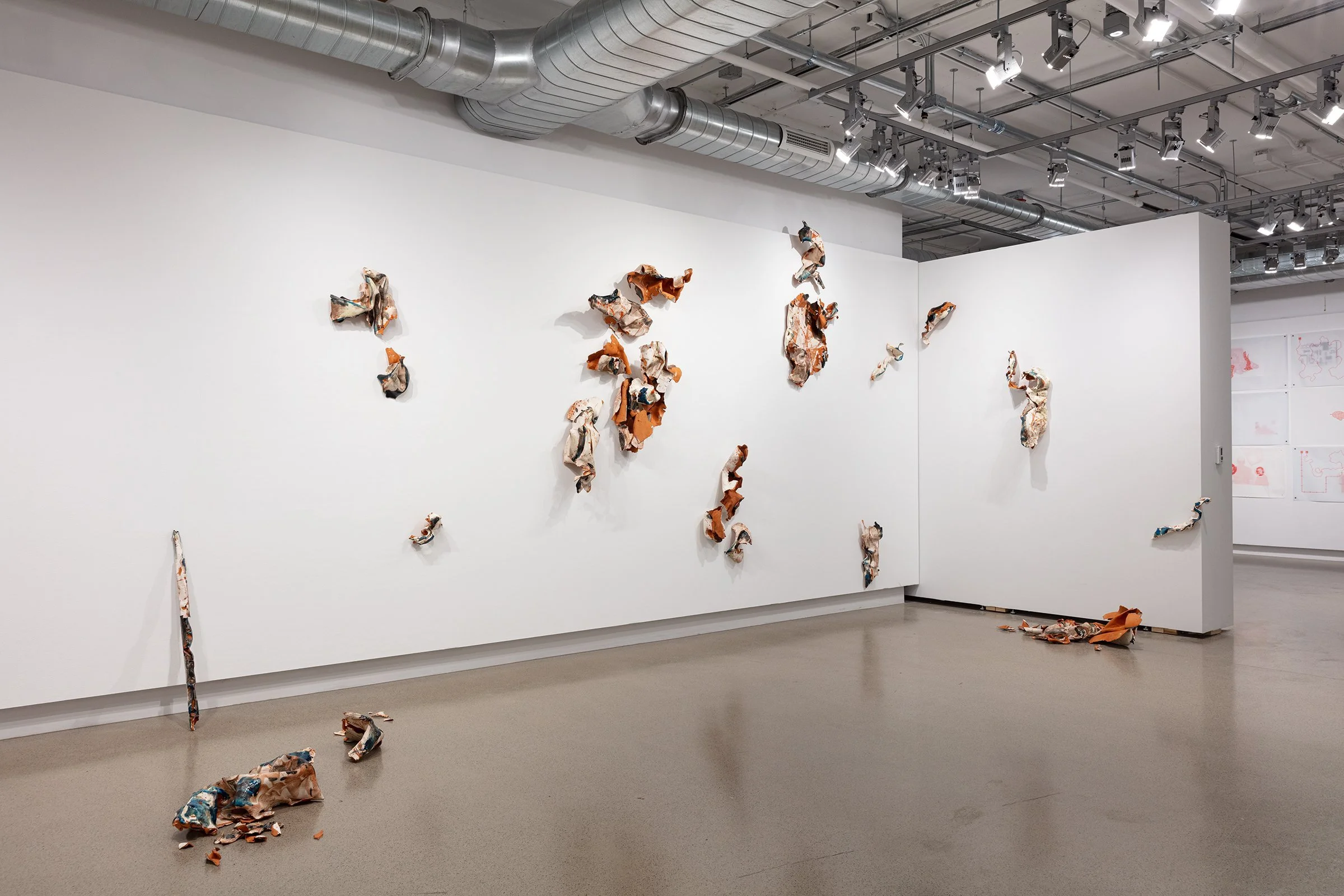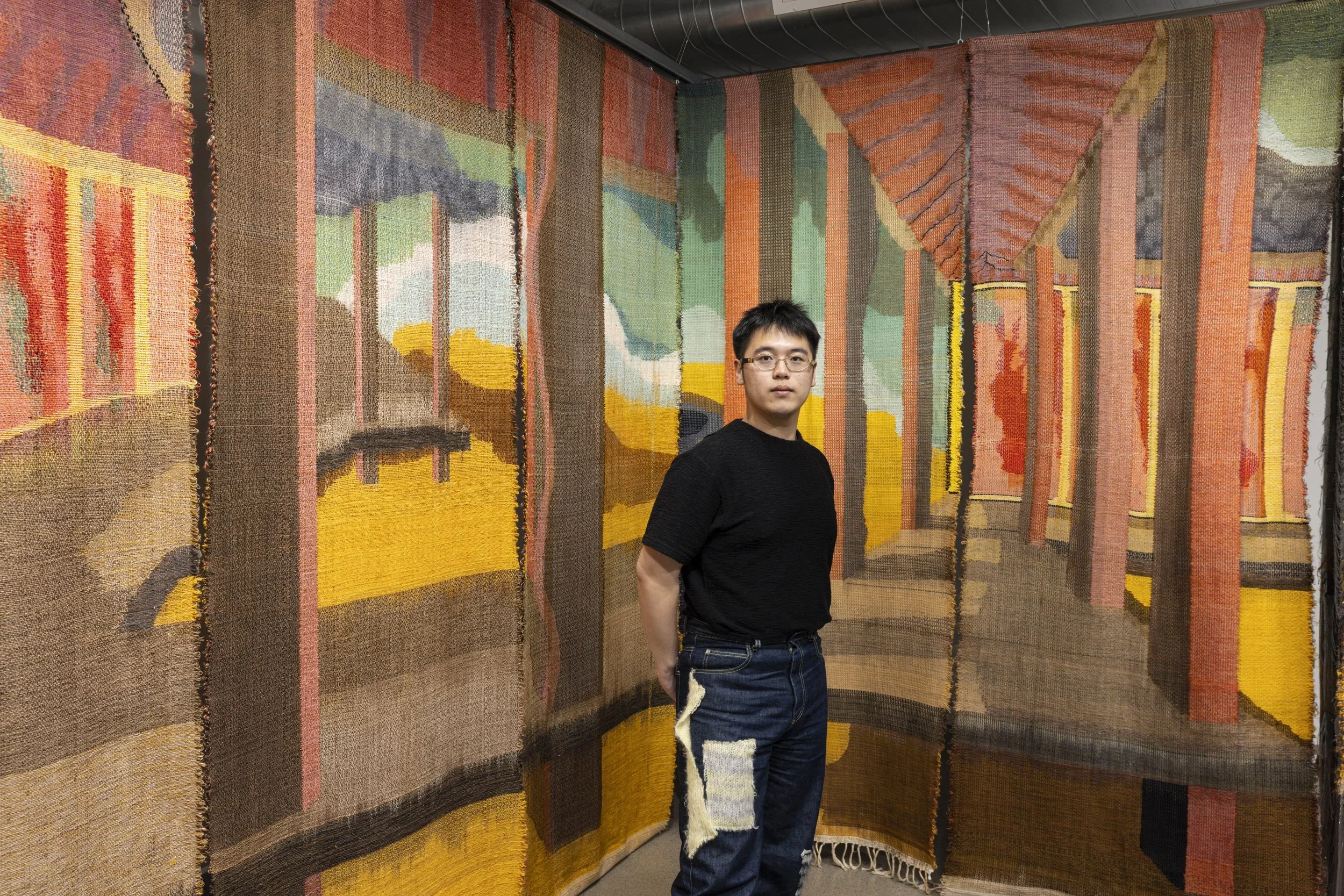10 Questions with Nanxi Jin
Al-Tiba9 Art Magazine ISSUE14 | Featured Artist
Nanxi Jin is an interdisciplinary artist who works with clay. She currently lives and works in Chicago. She obtained a BFA in Art & Design from New York State College of Ceramics at Alfred University in 2020. She graduated from the School of Art Institute of Chicago in 2022. Her works have been exhibited in multiple exhibitions, including Ceramic Art Avenue Gallery (2019), NYCxDesign during New York Design Week 2021, and :iidrr Gallery (2023). She received the First Prize in the 2022 "Shiwan Cup" Youth Ceramics Competition, the Silver Medal of the 12th Chinese Ceramic Art Exhibition, and the Silver Award for the China Ethnic Arts and Crafts Competition. Her work "Various Vase" has been collected in Guangdong Shiwan Ceramic Museum.
Nanxi Jin - Portrait
ARTIST STATEMENT
“Ceramic is a permanent medium and I’m a reluctant visitor.”
As a Chinese artist living in the United States for the past decade, Nanxi Jin has grappled with the tension between her early years in China, where she immersed herself in art centered around harmony, nature, and composition, and her art education in the US, which encouraged her to learn the rules in order to break them. This juxtaposition has greatly influenced her artistic journey, as she now combines her appreciation for harmony with the vibrant colors, conceptual leanings, and unrestricted expression of Eastern gestures inspired by Western landscapes she has discovered in Western aesthetics.
Raised in the traditional ceramic city of Jingdezhen, China, where perfection was the ultimate standard, Nanxi initially focused on mastering traditional techniques. However, clay, being a paradoxical material—both fragile and sturdy—has led her to reconsider its possibilities and explore its unique qualities. Nanxi now emulates the impressionistic gestures found in traditional pottery by intimately engaging with the clay, using touch and pinching techniques. Through gentle taps on the soft clay, she creates imprinted surfaces that visually and materially record the passage of time. This process establishes an emotional bond with the material and allows the clay itself to guide her artistic expression. By embracing imperfections and welcoming mistakes and chaos, she has found liberation in my creative process.
Escape Plan, Ceramic, Variable dimensions, 2022 © Nanxi Jin
Get your limited edition copy now
INTERVIEW
Please, introduce yourself to our readers. What is your background and how did you start getting involved with art?
Hello everyone; my name is Nanxi Jin. I was born in Jingdezhen, China, a city known for its rich tradition in ceramic-making. Growing up in this artistic environment, I had the privilege of gaining early exposure to ceramic-making techniques. Coming from a family of artists, both my parents are talented ceramic artists. During my formative years, I spent most of my time at their studio, observing and learning from their expertise. I guess that is where I start my art journey.
You come from Jingdezhen, China, a town famous for ceramics and also the material you use for your work. How much did your upbringing in China influence your choice of mediums when you decided to go into art?
Surrounded by the rich history and craftsmanship of ceramics, I developed a deep appreciation for the material and its artistic potential from an early age. The heritage of Jingdezhen's ceramic traditions and the skilled artisans who have practiced there for centuries inspired me to explore and experiment with clay as a means of artistic expression.
Escape Plan, Ceramic, Variable dimensions, 2022 © Nanxi Jin
At the same time, you studied in the USA, and this profoundly impacted your practice, as you highlighted in your statement. What aspects of the Eastern and Western cultures do you apply to your work? And how did you come to choose these aspects specifically?
From Eastern culture, I incorporate a reverence for tradition, a deep appreciation for craftsmanship, and an emphasis on harmony and balance. These aspects resonate with me on a personal and cultural level, as they are deeply ingrained in my upbringing and artistic sensibilities. I am drawn to the elegance, subtlety, and introspective qualities found in traditional Eastern art forms such as ink painting and ceramics. The philosophy of capturing the essence of nature and conveying profound emotions through simplicity greatly influences my creative process.
On the other hand, Western culture has influenced my work in terms of experimentation, innovation, and conceptual exploration. Exposure to Western artistic movements and contemporary practices has encouraged me to push boundaries, challenge conventions, and embrace a more expansive artistic vocabulary. I am intrigued by the freedom of expression, the focus on individuality, and the conceptual depth found in Western art. These influences have encouraged me to explore unconventional techniques, experiment with new materials, and engage with contemporary ideas.
Your ceramic works are peculiar and sometimes far from what one would expect from ceramics. They have organic shapes and do not resemble traditional clay pieces. How did you come up with this style?
During my time in school, I had the opportunity to study design, which taught me a valuable lesson about the uniqueness of different materials. I realized that selecting the right material is crucial in achieving the desired outcome for a particular subject. This led me to contemplate the exceptional qualities of clay. One of the most striking aspects is its organic nature, allowing for the creation of expressive and sculptural forms. Additionally, clay possesses the advantage of being easily malleable, enabling the fabrication process to be efficient and timely. Therefore, while many people may choose to create highly refined and structured forms with clay, I strive to break away from these aesthetic norms. Instead, I aim to amplify and highlight the inherent characteristics of clay in the final presentation of my work.
Escape Plan, Ceramic, Variable dimensions, 2022 © Nanxi Jin
Escape Plan, Ceramic, Variable dimensions, 2022 © Nanxi Jin
Escape Plan, Ceramic, Variable dimensions, 2022 © Nanxi Jin
You work with clay in a very specific way. Can you talk us through the process, from ideation to the final product?
Another aspect I deeply appreciate about working with clay is its extraordinary capacity to capture and preserve the essence of time in a distinctive manner. Clay, for me, serves as a medium through which I can document and embody tactile experiences. While perfume can evoke olfactory sensations and a camera can freeze visual moments, clay possesses the remarkable ability to record the passage of time through touch. Unlike a camera that captures a singular point in time, clay acts as a witness to an entire temporal journey. From the initial imprint of a finger on the malleable surface to the final firing process, every tactile interaction is imprinted and retained within the very fabric of the clay itself. It becomes a faithful recorder of these experiences, holding within it a tangible and visual chronicle of the creative process.
Within my sculptural works and installations, I seek to delve into the profound concepts of time and space. By incorporating the impressionistic gestures found in traditional art forms, I utilize clay not only to embellish and emphasize form but also to encapsulate the essence of time itself. Each gentle tap and deliberate mark on the malleable clay surface becomes a visual and material testament to the progression of time. It brings me immense joy to engage in collaborative endeavors with various spaces, continuously challenging myself to comprehend and interpret their unique characteristics. Through this process, I strive to grasp the very essence of each environment, seamlessly integrating it into my artistic vision. In doing so, I document the captivating interplay between my creations and the surrounding space, creating an immersive experience that harmonizes art and its environment.
Speaking of your work, you often use very subtle and muted colors. What do they represent for you? And how do you choose them?
Colors hold a special place in my artistic expression. In my earlier works, I found myself drawn to vibrant and lively color palettes, reflecting the simplicity and innocence of my student life. During that period, my creative mindset was free from the pressures of the outside world. However, since completing graduate school, I have observed a natural evolution in the colors I use in my work. They have taken on a more subdued and mature quality, signifying the growth and stability I have gained as an artist. This shift in color choices reflects a deeper understanding and exploration of my artistic journey.
Escape Plan, Ceramic, Variable dimensions, 2022 © Nanxi Jin
Have you ever used any other material other than ceramics? And how does your approach change based on the materials you use?
Yes, indeed, I have had the opportunity to work with various materials during my time in school. In addition to ceramics, I have gained experience in working with wood, glass, printmaking, and other mediums. Each material operates in its own unique way, requiring different techniques and approaches. While I have explored and experimented with different mediums, ceramics remains my primary material of choice. I have always aimed to break free from the traditional limitations of ceramics and collaborate with other materials. This multidimensional approach has allowed me to push the boundaries of my work and explore new realms of creativity.
Speaking of different materials, is there any other technique or medium you would like to incorporate into your practice?
One area of interest is the incorporation of felt, fiber, and traditional materials/techniques, such as bamboo weaving alongside ceramics. Additionally, I am keen to delve into the realm of large-scale installations and further experiment with the integration of performance, video, and sound elements. These multidisciplinary approaches offer exciting possibilities for pushing the boundaries of my artistic practice and engaging viewers in new and immersive experiences. I would love to try it again.
TimeTunnel, Stoneware, 65x12x25 inches, 2020 © Nanxi Jin
Various Vase, Stoneware, 46x20.5x29 inches, 2020 © Nanxi Jin
What are you working on now? Do you have any new projects or series you are currently developing? Or any upcoming exhibition you would like to share with our readers?
I just had my solo show in May. I am working on creating a series of ceramic celadon tableware. Inspired by the delicate beauty of celadon glazes, I am also dedicating my time to crafting small ceramic sculptures. It is preparing for two upcoming competitions in China. These competitions provide an opportunity for me to showcase my artistic skills, creativity, and unique approach to ceramics. As for exhibitions, while I do not have any immediate ones scheduled, I am actively seeking opportunities to participate in group shows and collaborative projects.
And lastly, we are exactly halfway through 2023. What is your biggest goal for the rest of the year?
As we reach the halfway mark of 2023, my primary goal for the remainder of the year is to secure the artist visa that will enable me to work and reside here in the United States, fostering the development of my artistic journey and opening doors to increased exposure and opportunities. I am deeply committed to honing my artistic voice, delving into new concepts, and constantly evolving as an artist. Additionally, I aspire to engage in meaningful collaborations and participate in exhibitions that facilitate connections with fellow artists and art enthusiasts, fostering dialogue and expanding the reach of my work.
Artist’s Talk
Al-Tiba9 Interviews is a promotional platform for artists to articulate their vision and engage them with our diverse readership through a published art dialogue. The artists are interviewed by Mohamed Benhadj, the founder & curator of Al-Tiba9, to highlight their artistic careers and introduce them to the international contemporary art scene across our vast network of museums, galleries, art professionals, art dealers, collectors, and art lovers across the globe.


























